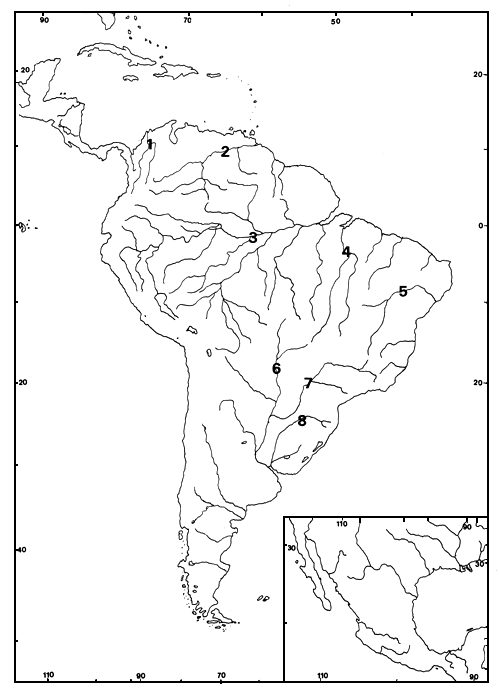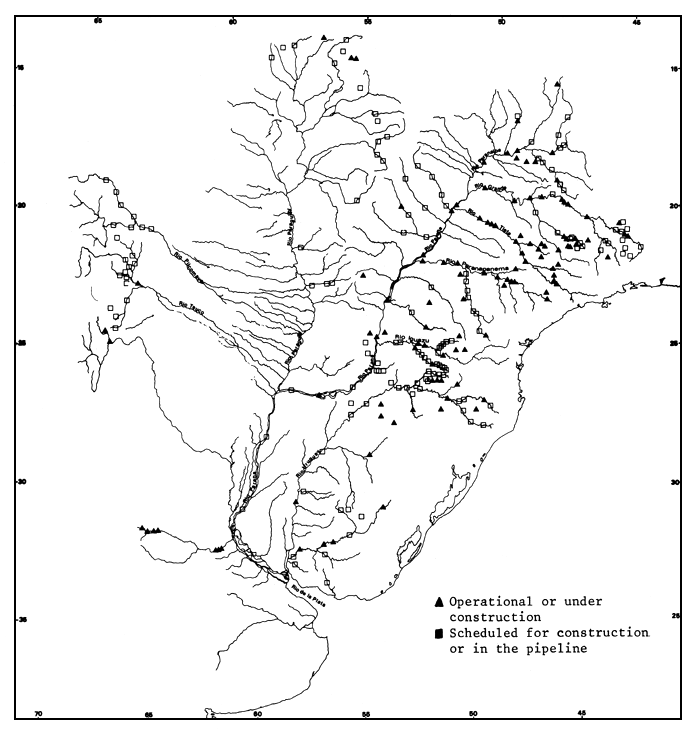The fact that almost nothing is known of the swimming ability of the region's fish coupled with the lack of available data on their swimming physiology means that it is impossible to establish broad guidelines regarding the most suitable fish-pass designs. This situation is further aggravated by the fact that there are no recent laws to protect fish communities in large Latin American rivers from the negative effects of development. Most dams have not been provided with structures to pass fish upstream. Some reservoirs, fish hatcheries, producing fingerlings, have been established with purpose of regular stocking.
The first fish-pass structures built in the region were the type used in the northern hemisphere for passing salmonids upstream - a channel equipped with flow deflectors - and these have been reported to have failed insofar as their handling capacity is concerned. The pool and weir-type designs with vertical slots have been shown to be effective for passing Prochilodus, Salminus and Leporinum upstream and for surmounting obstacles up to 15 m high. Borland-type locks are also in use and mechanical elevators are under construction in two dams on the Uruguay and Paraná rivers. There are plans to build passes to enable fish to overcome obstacles of over 20 m in height. These will be designed to provide a higher overall handling capacity.
In line with suggestions made previously by other workers in the region, the author proposes that fish pass installations be used in conjunction with fishery management methods involving the stocking of migratory species.
On the whole, Latin America (Figure 1) is relatively flat. With the exception of the rivers draining the Andes to the Pacific and the upper reaches of the rivers draining to the Caribbean Sea and the Atlantic, most of its rivers are of the lowland type, consisting of extensive floodplains (Welcomme, 1985).
Fish communities in the large rivers comprise mainly characins and siluroids. Among the characins, prochilodids of the genera Semaprochilodus and Prochilodus constitute a large proportion of catches (Bonetto, Dioni and Pignalberi, 1969; Bonetto and Castello, 1985). In some systems, they account for more than 60 to 70% of the total catch.
During their life cycles, the large characins and siluroids need to undertake long migrations in the large rivers and their main tributaries for breeding and feeding purposes (Petrere, 1985). In upper and middle reaches, these migratory movements follow an established pathway. In lower reaches, however, migratory dynamics are much more complex, particularly where the fishes' interaction with the main channel and the floodplain is concerned (Bonetto, Canon Verón and Roldán; 1981; Petrere, 1985; Quirós and Cuch, 1986).
Dam construction has had a negative effect on communities of migratory species. This effect is particularly damaging where a number of dams have been built in the same reach. This is the case in the Tiete and Grande rivers in the upper watershed of the Paraná river, where migratory species have virtually disappeared (Machado, 1976).
As new dams are built, these negative effects could extend to an entire basin. An inventory of the energy potential of the Plata basin (not yet completed) shows that 278 dams could be constructed. Out of a total of 183 dams scheduled for the Paraná river sub-basin, 65.9% are either already in operation or under construction. In the sub-basins of the Uruguay and Paraguay rivers a significantly smaller proportion of the total number (52 in Uruguay and 43 in Paraguay) is currently in operation (OEA, 1985). When the plan is completed, almost the entire basin will be regulated and will consist of a chain of reservoirs (Figure 2). The same can be expected to happen in other large drainage basins in Latin America. Thirty two dams have either been built or are under construction in Magdalena river basin and others are envisaged for the upper and middle reaches of the Magdalena river. The result will be a chain of reservoirs (Valderrama Barco, 1986). The Tres Marías and Sobradinho dams in the San Francisco river are insurmountable obstacles for migrating fish. There are relatively few dams in the Amazon and Orinoco basins at the present time. However, appropriate measures will have to be taken so that current plans for gradual construction do not lead to a situation similar to that prevailing in the other catchment basins mentioned.

Figure 1 Major Latin American catchment basins. 1. Magdalena; 2. Orinoco; 3. Amazon; 4. Tocantins; 5. San Francisco; 6, 7 and 8. La Plata basin (6. Paraguay river; 7. Paraná river; 8. Uruguay river)

Figure 2 Hydroelectric dams already built or scheduled for construction in the Plata river basin (adapted from OEA, 1985)
One major impact of dam construction is that the dams obstruct the movements of the rivers' fish communities. The construction of fish passes in the dams is one way of reducing this negative effect. One of the measures taken in Latin America was the installation of fish passes similar to those which work so satisfactorily for the salmons in Northern hemisphere temperate rivers (Welcomme, 1985).
Brazilian authorities passed a law providing for the installation of fish pass structures in dams. However, considerable controversy arose in the thirties as to whether the installation of such structures was the most appropriate way, both technically and economically, of protecting migratory species in the large rivers. The development, by Von Ihering and his team, of induced breeding techniques for several “piracema” species and the lack of experience with fish passes for species other than salmonids resulted in the law being amended. It no longer specifies the type of measure to protect the fish fauna; one can now chose between fish pass installations and fish culture stations (see Section 8). Fish pass structures have been installed only in very few of the dams constructed in Brazil and the rest of Latin America since then and no assessments have been done as to whether it is technically feasible to install such structures. The controversy has continued up to the present time and is reflected in papers prepared in the region (Bonetto, 1980; Bonetto and Castello, 1985; Godoy, 1985) and in works analysing the technical and economic feasibility of such structures for one or for several dams (e.g., Machado, 1976; Valderrama Barco, 1986).
Another point, which has led to some ambiguity, is that the generic term “fishway” covers several different types of installation (Clay, 1961): pools or tanks, or chutes equipped with flow deflectors. The term pool and weir fish pass is somewhat clearer, although this name includes a wide range of designs of varying efficiency even where salmonids are concerned.